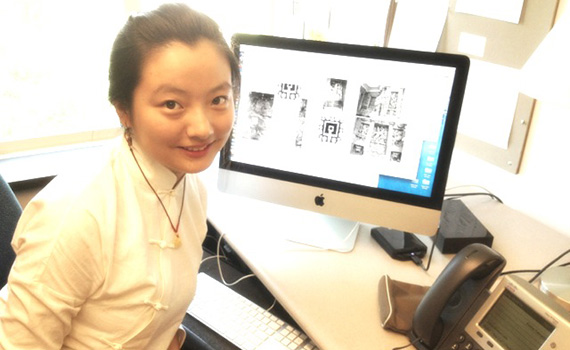51Ěš┴¸ students are sharing their experiences conducting research with faculty members on campus and in the field. This post is by Shan Wu ÔÇÖ15, a double major in and the , from Hangzhou, China.
This summer I have been assisting with her book manuscript Many Paths to the Divine. It analyzes one of the canonical monuments of Indic architecture: the eighth-century Kail─üsan─ütha temple in Kanchipuram, a city in IndiaÔÇÖs southern-most state of Tamilnadu.
The chapter of the book I have worked on most examines the narrative sculptures and inscriptions on the temple walls in detail. In addition, the book discusses circumambulation ÔÇö the act of walking around the monuments ÔÇö and challenges the perception that moving in a counterclockwise direction is forbidden and unorthodox.
Shan Wu composed illustrations such as these for Professor KaimalÔÇÖs manuscript.
My work has involved boiling down the sculptural and narrative information on the Kail─üsan─ütha temple walls to a minimum number of plans and photos in order to make them accessible to both the non-specialist and professional reader.
The inscriptions on the temple walls often break and bend mid-word around the multi-faceted structure, and the sculptures usually do not follow linear logic. In the diagrams IÔÇÖve made, the texts are accompanied by figures that are most representative in posture, style, and symbolism. Because the sculptural elements, their sequence, and their subtle connection with the Sanskrit inscriptions are crucial to the readerÔÇÖs understanding of the experience of circumambulation, I have emphasized the various pivot points and moments around the walls.
I have been working with an amazingly dynamic assemblage of hundreds of photographs, labeled plans, different versions of Sanskrit translations, and sources provided by Professor Kaimal and other scholars who have studied this temple in situ. So far I have designed illustrations and plates that consist of marked ground plans, translations of the on-site inscriptions, and photographs that will appear in the book.
I have always been intrigued by ancient civilizations and their derivative studies, especially ancient languages, religion, and art.
Born and raised in a family of classical Chinese calligraphers and artists, I am attracted to the decoding and unfolding of ancient mysteries and myths. I have spent most of my time at 51Ěš┴¸ trying to reconcile my Han Chinese sensibility with what I have learned as a curious student of the West.
Although to some, the distant past may sound prehistoric or irrelevant, I draw most of my intellectual stimuli from it. I have been working on academic projects that help assimilate ideas inspired by ancient art and culture into forms synchronic with modernity/post-modernity.
The sculptures and Sanskrit text are strongly evocative of my underlying Far Eastern aesthetic; they are mysterious and yearn for revelations.
The Kail─üsan─ütha Temple project has given me a great chance to work intimately with primary sources from ancient India; present the beautiful eighth-century philosophical and religious ideas preserved in visual art in succinct, accessible forms; learn from the studies of accomplished scholars; and most importantly, to examine my own subjectivity.
After graduating, I wish to continue studying ancient cultures and working on projects that explore extremes ÔÇö Far East and West, old and new, sacred and mundane.

